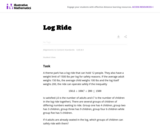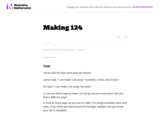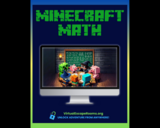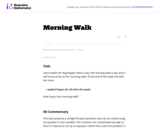
This word problem requires students to compute sales tax.
- Subject:
- Math
- Material Type:
- Activity/Lab
- Provider:
- Illustrative Mathematics
- Provider Set:
- Illustrative Mathematics
- Author:
- Illustrative Mathematics
- Date Added:
- 05/01/2012

This word problem requires students to compute sales tax.

This word problems helps students learn to build the biggest three-digit number given any three numbers between 0 and 9 to use as digits.

In this instructional task students are given two inequalities, one as a formula and one in words, and a set of possible solutions. They have to decide which of the given numbers actually solve the inequalities.

The purpose of this task is for students to compare two options for a prize where the value of one is given $2 at a time, giving them an opportunity to "work with equal groups of objects to gain foundations for multiplication." This context also provides students with an introduction to the concept of delayed gratification, or resisting an immediate reward and waiting for a later reward, while working with money.

This task is for students who know how to use base 10 blocks.

This task provides three types of comparison problems: Those with an unknown difference and two known numbers; those with a known difference and a bigger unknown number; and those with a known difference and smaller unknown number. Students may solve each type using addition or subtraction, although the language in specific problems tends to favor one approach over another.

The purpose of the task is for students to solve a multi-step multiplication problem in a context that involves area. In addition, the numbers were chosen to determine if students have a common misconception related to multiplication.

Students work in pairs to measure blocks and answer word problems.

In this task students are asked to write two expressions from verbal descriptions and determine if they are equivalent. The expressions involve both percent and fractions. This task is most appropriate for a classroom discussion since the statement of the problem has some ambiguity.

"This free ebook includes over 20 Minecraft themed word problems covering addition and subtraction, multiplication, division and multi-step word problems geared towards students in grades 2-5.
The ebook also includes a step-by-step guide for instantly creating your own Minecraft Math activities using a free tool from SchoolAI!
Teach High School? Got a bunch of Swifties or Fortnite fans? You can swap out the prompt and make resources based on your grade level and whatever your students love!"

This task presents a straight forward question that can be solved using an equation in one variable. The numbers are complicated enough so that it is natural to set up an equation rather than solve the problem in one's head.

This lesson is a re-engagement lesson designed for learners to revisit a problem-solving task they have already experienced. Students will activate prior knowledge of graphical representations through the 'what's my rule' number talk; compare and contrast two different learners' interpretations of the growing pattern; use multiple representations to demonstrate how one of these learners would represent the numeric pattern; make connections between the different representations to more critically compare the two interpretations. (5th/6th Grade Math)

This real world word problem requires multiple steps.

(Nota: Esta es una traducción de un recurso educativo abierto creado por el Departamento de Educación del Estado de Nueva York (NYSED) como parte del proyecto "EngageNY" en 2013. Aunque el recurso real fue traducido por personas, la siguiente descripción se tradujo del inglés original usando Google Translate para ayudar a los usuarios potenciales a decidir si se adapta a sus necesidades y puede contener errores gramaticales o lingüísticos. La descripción original en inglés también se proporciona a continuación.)
Este módulo de 25 días se basa directamente en los estudiantes que trabajan con multiplicación y división en el módulo 1. El módulo 3 extiende el estudio de factores de 2, 3, 4, 5 y 10 para incluir todas las unidades de 0 a 10, así como múltiples de 10 dentro de 100. Similar a la organización del Módulo 1, la introducción de nuevos factores en el módulo 3 se extiende a través de temas. Esto permite a los estudiantes construir fluidez con hechos que involucran una unidad en particular antes de continuar. Los factores están secuenciados para facilitar la instrucción sistemática con estrategias y patrones cada vez más sofisticados.
Encuentre el resto de los recursos matemáticos de Engageny en https://archive.org/details/engageny-mathematics.
English Description:
This 25-day module builds directly on students work with multiplication and division in Module 1. Module 3 extends the study of factors from 2, 3, 4, 5, and 10 to include all units from 0 to 10, as well as multiples of 10 within 100. Similar to the organization of Module 1, the introduction of new factors in Module 3 spreads across topics. This allows students to build fluency with facts involving a particular unit before moving on. The factors are sequenced to facilitate systematic instruction with increasingly sophisticated strategies and patterns.
Find the rest of the EngageNY Mathematics resources at https://archive.org/details/engageny-mathematics.

(Nota: Esta es una traducción de un recurso educativo abierto creado por el Departamento de Educación del Estado de Nueva York (NYSED) como parte del proyecto "EngageNY" en 2013. Aunque el recurso real fue traducido por personas, la siguiente descripción se tradujo del inglés original usando Google Translate para ayudar a los usuarios potenciales a decidir si se adapta a sus necesidades y puede contener errores gramaticales o lingüísticos. La descripción original en inglés también se proporciona a continuación.)
Este módulo final del año de 40 días ofrece a los estudiantes una práctica intensiva con problemas de palabras, así como experiencias prácticas de investigación con geometría y perímetro. El módulo comienza con la resolución de problemas de palabras de uno y dos pasos basados en una variedad de temas estudiados durante todo el año, utilizando las cuatro operaciones. A continuación, los estudiantes exploran la geometría. Estudiantes Tessellate para la experiencia de la geometría de puente con el estudio del perímetro. Las parcelas de línea, familiares del Módulo 6, ayudan a los estudiantes a sacar conclusiones sobre las mediciones de perímetro y área. Los estudiantes resuelven problemas de palabras que involucran área y perímetro utilizando las cuatro operaciones. El módulo concluye con un conjunto de lecciones atractivas que revisan brevemente los conceptos fundamentales de grado 3 de fracciones, multiplicación y división.
Encuentre el resto de los recursos matemáticos de Engageny en https://archive.org/details/engageny-mathematics.
English Description:
This 40-day final module of the year offers students intensive practice with word problems, as well as hands-on investigation experiences with geometry and perimeter. The module begins with solving one- and two-step word problems based on a variety of topics studied throughout the year, using all four operations. Next students explore geometry. Students tessellate to bridge geometry experience with the study of perimeter. Line plots, familiar from Module 6, help students draw conclusions about perimeter and area measurements. Students solve word problems involving area and perimeter using all four operations. The module concludes with a set of engaging lessons that briefly review the fundamental Grade 3 concepts of fractions, multiplication, and division.
Find the rest of the EngageNY Mathematics resources at https://archive.org/details/engageny-mathematics.

These problems would be great for number talks or higher order thinking.

The purpose of this task is to provide students an opportunity to use mathematics addressed in different standards in the same problem.

The point of this task is to emphasize the grouping structure of the base-ten number system, and in particular the crucial fact that 10 tens make 1 hundred.

This task provides a context where it is appropriate for students to subtract fractions with a common denominator; it could be used for either assessment or instructional purposes.

This word problem requires students to use addition and subtraction and think about money.